If you’re shopping for new cookware, you may easily find yourself in a pickle. Not only that there are so many options, but you may even end up with the wrong choice for your needs. The materials used are various and come with different properties so doing your homework before shopping seems like the most reasonable thing to do.
Without any further ado, let’s take a closer look at some of the most popular choices out there so that it becomes clear to you which material is going to fit your needs and wallet the best way.
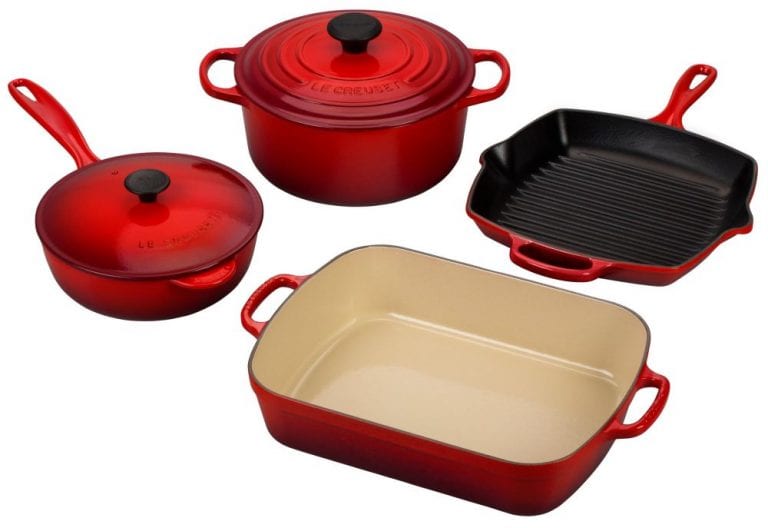
image source: amazon.com
Contents
- Cast iron cookware
- Is enameled cast iron a better choice?
- Should you choose stainless steel cookware?
- Is carbon steel a good option?
- Should you look into the copper cookware?
- Is aluminum a solid choice for cookware?
- Is the non-stick cookware really that great?
- Have you ever considered glass cookware?
- What’s the story with ceramic cookware?
- Is silicone cookware a solid option?
- One last thought before you go
Cast iron cookware
Cast iron is safe to use for stovetop, grill, oven, broiler and even on direct fire. You should use it for baking, roasting, searing, stove-to-oven recipes and even frying.
Durable and versatile, cast iron conducts heat really well and it can cook on stove, oven and grill.
The main downside in the case of cast iron is the difficulty of taking care of it. As long as you follow some tips for cleaning, it shouldn’t be difficult to anyone to clean and maintain the cast iron cookware in good shape for a long time.
Here’s why you should use cast iron cookware:
- It’s affordable and long lasting
- Once it’s hot, it remains that way
- It’s highly versatile and allows you to cook in any medium
- As long as you season it accordingly, it’s naturally non-stick
Take a look at the downsides as well, for completing the picture:
- It may rust, chip and crack if you’re not taking good care of it
- It sits on the heavy weight side
- It’s not easy to take care of
- It’s pretty reactive so you should avoid the acidic foods with it.
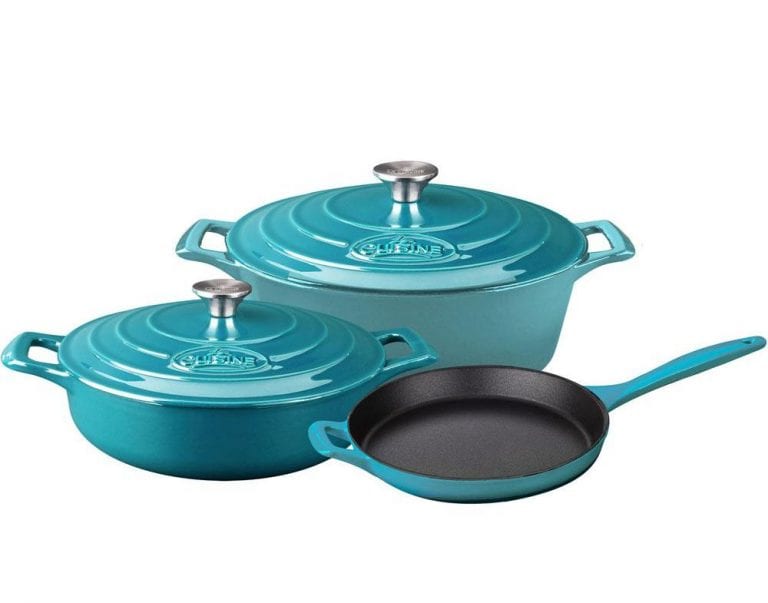
image source: homedepot.com
Is enameled cast iron a better choice?
Enameled cast iron is great for stovetop and oven, ensuring the similar benefits to classic cast iron, without the seasoning challenge.
In addition, the enameled cast iron comes in a nice variety of colors and models, but it’s a bit pricier than the classic one.
Even though enameled cast iron is going to need plenty of time to heat up, it’s also able to retain the heat really well. This is why it’s a great material for browning and transferring from the stovetop to the oven.
Here are the best parts about it:
- It’s durable and takes the high heat very well
- It’s non-reactive so it’s good for slow cooking the acidic and alkaline foods
- It looks nice and comes in many colors
- You don’t need to season it
- It’s great in terms of heat conduction and retention
The negatives aren’t many, but you should check them anyway:
- It’s pricier than the traditional cast iron
- It’s really heavy
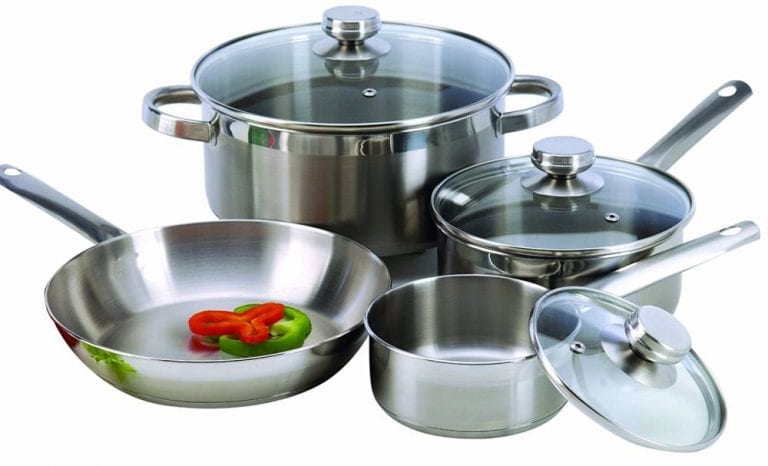
image source: amazon.com
Should you choose stainless steel cookware?
Durable, dishwasher-safe, non-reactive and resistant to scratching, rust and denting, the stainless steel fits any kitchen décor.
It may not be the best heat conductor (it’s quite the opposite!), which is why finding stainless steel cookware that has a core of other kind of metal that conducts heat better is important.
Here’s why you should look into stainless steel cookware:
- It’s long lasting
- It’s non-reactive
- It’s dishwasher safe
- It’s resistant to denting, rust, and scratching
- It’s affordable
The flaws of stainless steel cookware are important to mention:
- If it comes with copper core, it can get pricey
- Its heat conductivity is rather poor
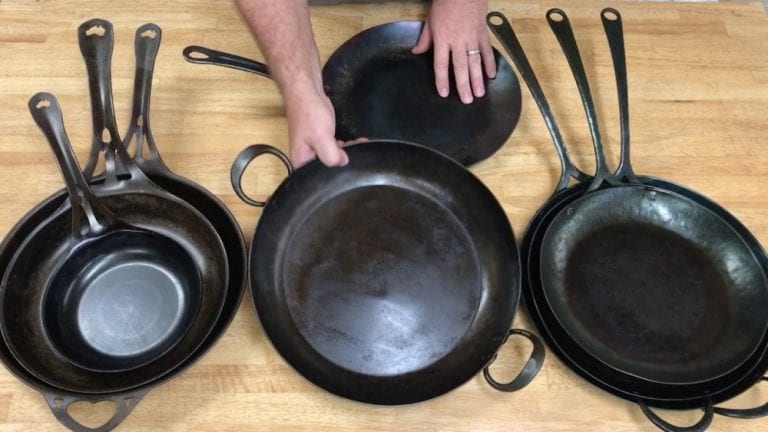
image source: youtube.com
Is carbon steel a good option?
Carbon steel cookware is a cross between the cast iron and stainless steel. However, you need to season it, knowing that it’s only going to get better in time. You cannot put it in the dishwasher or leave it sit in the water either.
Let’s see which are the selling points for the carbon steel cookware:
- It’s a great heat conductor
- It’s naturally non-stick
- It’s lighter than cast iron
- It’s affordable and takes the use for a long time
The inherent flaws aren’t major:
- It retains less heat than cast iron
- It may become reactive with acidic and alkaline foods
- The risk for rust and corrosion isn’t null, but you should be fine when taking good care of it.
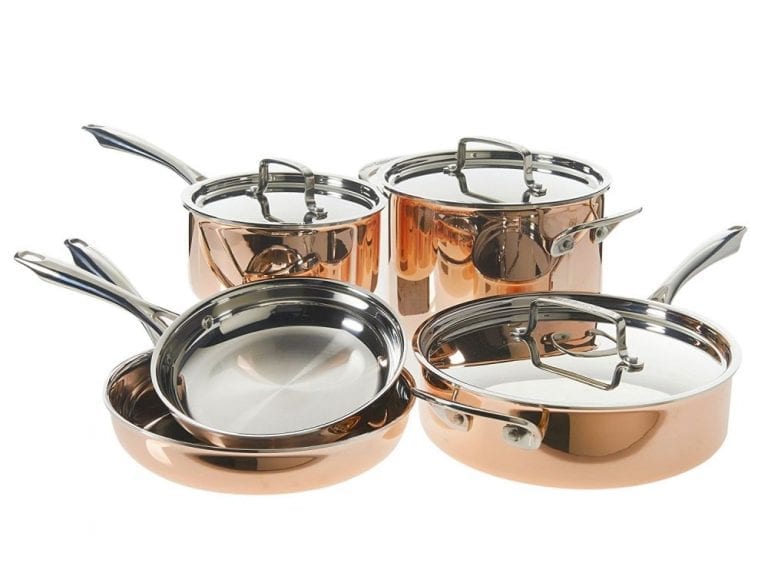
image source: amazon.com
Should you look into the copper cookware?
Copper is an amazing heat conductor but it’s a reactive metal. It has to be lined with another material (tin or stainless steel are common options).
Here’s why copper cookware may work:
- It heats really quick
- It’s the best heat conductor. It heats food evenly and also adjusts the temperature changes really fast.
The downsides may throw you off a bit:
- It’s not cheap at all
- You need to polish it on a regular basis
- It doesn’t work on induction cooktops
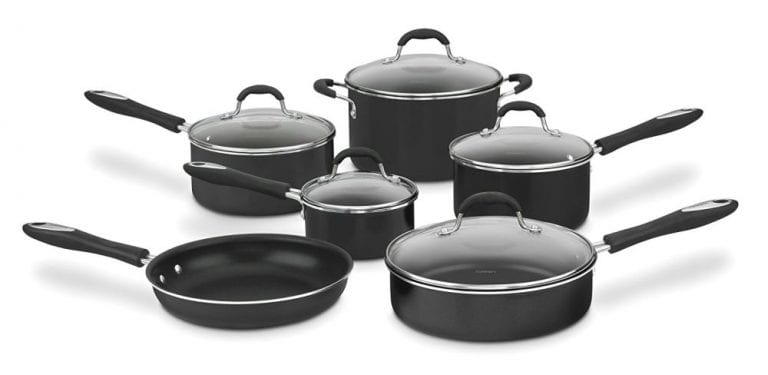
image source: amazon.com
Is aluminum a solid choice for cookware?
Soft and reactive, aluminum needs to go through several processes in order to be used as cookware. It’s really popular for bakeware and aluminized steel baking pans and sheets are the no.1 choice for many professional bakers.
Here are the best parts about aluminum:
- It’s strong and scratch-resistant
- It’s lightweight and comes for a good price
- It presents great thermal conductivity
- It’s a good heat conductor
Don’t let the minor issues stand in your way when choosing:
- It’s not the best option for sweet baked goods
- Regular anodized aluminum doesn’t work on induction burners.
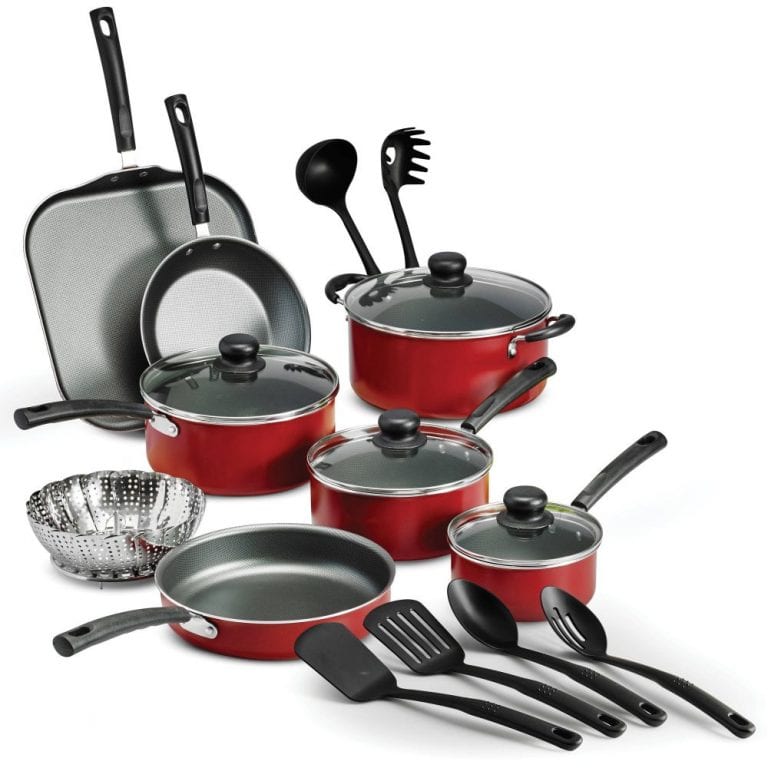
image source: walmart.com
Is the non-stick cookware really that great?
Despite of what one may think, the non-stick pans aren’t the best choice for every single job in the kitchen. Nevertheless, they do sustain your cooking with less fat and are a lot easier to clean.
Let’s see the main good things related to non-stick cookware:
- It’s non-reactive and non-porous
- Eggs, fish and other fragile foods don’t stick to the pan nor break apart
- It allows cooking with less fat
- It can be a great heat conductor
Don’t forget to look at the negatives as well:
- It may not take the use for a very long time. Despite what the companies may state, non-stick pans need to be replaced every 2 to 4 years.
- It doesn’t handle high heat very well.
- You must use only wooden and plastic (nylon, silicone) utensils. The metal ones are going to scratch the non-stick coating.
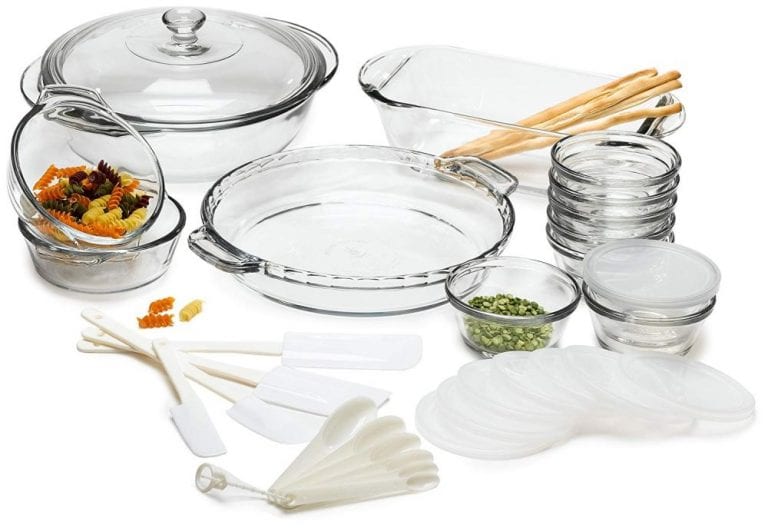
image source: amazon.com
Have you ever considered glass cookware?
Glass baking dishes are a nice addition to any kitchen. Glass is non-reactive and conducts heat pretty waell, which makes it really versatile.
Here’s why you should give glass cookware a chance:
- It’s a good heat conductor
- It’s non-reactive
- It’s not as pricey as ceramic
The downsides may be deal breakers in some situations:
- It may cause sugar to burn as it conducts heat so well
- You shouldn’t use it for broiling as high temperatures cause the glass to shatter
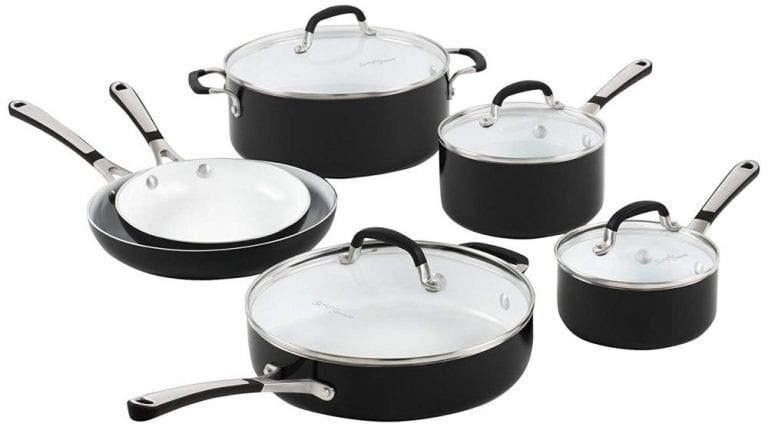
image source: amazon.com
What’s the story with ceramic cookware?
Ceramic is a great option for the slow cooking as it heats up gradually. It’s non-reactive and great for the acidic and alkaline foods.
Ceramic baking dishes are really pretty so they always look amazing for oven-to-table serving.
Here’s what we like the most about ceramic:
- The dishes look nice
- It’s non-reactive so it works for acidic foods
- The smooth glaze is almost non-stick
- You may serve the food in the baking dish
The negatives could make some change their mind:
- It chips rather easy
- It can break easier
- You may over-brown the sweet food
image source: pinterest.com
Is silicone cookware a solid option?
From the pan liners to the muffin “tins”, the market gives us today so many silicone baking products.
Even though silicone cookware is typically non-stick, it may be difficult to un-mold some recipes. Cleaning them is no easy job either. It’s better that you stay away from the textured or waffled interiors.
Here are the good parts:
- It’s a great option for a kitchen with limited storage space. It’s really easy to fold and tuck away when not in use
- It’s dishwasher safe. This doesn’t mean throwing it in the dishwasher is going to leave it squeaky clean.
- It prevents sticking
- It’s not difficult to remove the baked items from the silicone mold. The edges and corners may get stuck, though.
The parts we like less about silicone cookware should be mentioned as well:
- It’s a lousy heat conductor
- Cleaning it can get frustrating, especially if the texture isn’t smooth. Even if nothing really sticks to the silicone, a slight film is always going to be left and removing it completely is quite the challenge.
- Baked goods don’t brown very well. It all depends on the recipe if this is a good or a bad thing.
One last thought before you go
As you can see, there are so many options in terms of materials for the cookware. One of the best online stores for cookware is CookwithMilo.com, They offer dutch oven made with quality enameled cast iron known for excellent heat retention and distribution. The heating seems even. And it’s very easy to clean, with the white remaining white inside. And thanks to the coupon codes for CookwithMilo.com, you can now save up to 40% on your next order. And if you are still undecided, you can read some of their client’s reviews: “Did this dutch oven change my life? No — that would be a silly claim. However, it is absolutely amazing. In the two weeks that I’ve had it, I’ve used it way more than I ever used my old Lodge dutch oven. It sits beautifully on my stovetop when not in use, garnering tons of compliments from my friends. 10/10 would recommend“, “Cooking with the Milo is an amazing experience. Very even heat distribution, excellent heat retention along with quick and easy clean up makes this a phenomenal product, let alone the great price point. Buy this and enjoy cooking with a quality product that will produce for you, literally for generations to come”.
